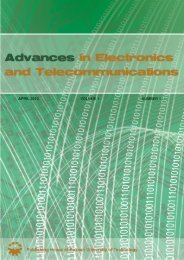november 2010 volume 1 number 2 - Advances in Electronics and ...
november 2010 volume 1 number 2 - Advances in Electronics and ...
november 2010 volume 1 number 2 - Advances in Electronics and ...
Create successful ePaper yourself
Turn your PDF publications into a flip-book with our unique Google optimized e-Paper software.
8 ADVANCES IN ELECTRONICS AND TELECOMMUNICATIONS, VOL. 1, NO. 2, NOVEMBER <strong>2010</strong><br />
only <strong>in</strong> one direction – towards the coord<strong>in</strong>ator.Therefore, the<br />
network is free of collisions <strong>and</strong> the <strong>in</strong>tensity of the operated<br />
traffic is the maximal possible.<br />
The results obta<strong>in</strong>ed for both network operation modes<br />
(non-synchronized <strong>and</strong> synchronized) are summarized <strong>in</strong><br />
Fig. 1. The effective transmission rate <strong>in</strong> the non-synchronized<br />
mode equals to 116 kb/s, correspond<strong>in</strong>g to the utilization of<br />
46 % of the channel operation time. The rema<strong>in</strong><strong>in</strong>g transmission<br />
rate of the system is absorbed by the transmission<br />
overhead <strong>and</strong> by the dead periods, related to the r<strong>and</strong>om<br />
delay of the moment start<strong>in</strong>g transmission. The effective<br />
transmission rate of the synchronized network is even worse<br />
<strong>and</strong> equals about 98 kb/s, correspond<strong>in</strong>g to 39 % of the<br />
assumed transmission rate. The supplementary b<strong>and</strong> losses<br />
result from the necessity of the periodical transmission of<br />
BEACON frame, the <strong>in</strong>creas<strong>in</strong>g of the channel occupation<br />
test, the <strong>in</strong>creas<strong>in</strong>g of the contention w<strong>in</strong>dow size <strong>and</strong> the<br />
non-utilization of the last fragment of the superframe, which<br />
rema<strong>in</strong>s empty because the transmitt<strong>in</strong>g node cannot manage<br />
to fit the entire transaction <strong>in</strong> it. The average length of this<br />
section corresponds to the half of the transaction time.<br />
The Fig. 1.b presents the relation between the coefficient of<br />
delivered packets <strong>and</strong> the <strong>in</strong>tensity of the offered traffic. The<br />
losses of frames appear only dur<strong>in</strong>g the overload<strong>in</strong>g of the<br />
system. The superiority of the traffic offered over the traffic<br />
operated leads to the overfill<strong>in</strong>g of the emitter’s queue <strong>and</strong> the<br />
result<strong>in</strong>g refusal of a certa<strong>in</strong> part of the requests.<br />
Thesame modelofthesystem, loadedwith a trafficdirected<br />
<strong>in</strong>asymmetricalwaytobothnodes,makesitpossibletodef<strong>in</strong>e<br />
the <strong>in</strong>fluence of the bidirectionaltransmission for the available<br />
transmission rate of the network. The obta<strong>in</strong>ed results are<br />
summarized <strong>in</strong> Fig. 2. Their values are not significantly worse,<br />
evenif it couldseemthatthe nodesshould<strong>in</strong>itiateacontention<br />
concern<strong>in</strong>g the access to the common channel, lead<strong>in</strong>g to<br />
collisions. In the LR-WPAN, the transactions realized <strong>in</strong><br />
both directions are <strong>in</strong>itiated by a s<strong>in</strong>gle slave station, so any<br />
contention is excluded. The decrease <strong>in</strong> the transmission rate<br />
of the transmission channel results from a worse efficiency<br />
of transmission directed towards the slave node. Any such<br />
transaction must start with the transmission of REQUEST <strong>and</strong><br />
ACK frames [1], <strong>in</strong>creas<strong>in</strong>g its duration.<br />
The coefficient of delivered packets, def<strong>in</strong>ed for the discussed<br />
configuration, has slightly changed because of the<br />
decrease <strong>in</strong> the transmission rate of the network (Fig. 2.b).<br />
The form of both curves rema<strong>in</strong>s identical, confirm<strong>in</strong>g a total<br />
operation of the requests directed toward a system free of<br />
overload<strong>in</strong>g.<br />
B. Influence of a hidden station on the transmission rate of<br />
the system<br />
The collisions caused by hidden stations are much more<br />
troublesome for the system than those result<strong>in</strong>g from the<br />
contention for the access to the radio channel. A long time<br />
of emission of a s<strong>in</strong>gle frame significantly <strong>in</strong>creases the<br />
probability of generat<strong>in</strong>g a new request directed to the hidden<br />
station <strong>in</strong> this period [2]. Its immediate realization will disturb<br />
the transactionbe<strong>in</strong>g already<strong>in</strong> progresswith the distant node.<br />
Fig. 1. Unidirectional transmission <strong>in</strong> a system consist<strong>in</strong>g of two nodes: a)<br />
<strong>in</strong>tensity of the operated traffic, b) coefficient of delivered packets<br />
Study<strong>in</strong>g the <strong>in</strong>fluence of the presence of a hidden station<br />
on the operation of the LR-WPAN network, we have used<br />
the model presented <strong>in</strong> Fig. 3. A centrally placed coord<strong>in</strong>ator<br />
works with two slave nodes, located out of their reciprocal<br />
range. The entire offered traffic is evenly divided between<br />
slave stations, which direct their transfers exclusively to the<br />
coord<strong>in</strong>ator.<br />
The results of simulation tests, summarized <strong>in</strong> Fig. 4,<br />
<strong>in</strong>dicate a radical decrease <strong>in</strong> the transmission rate of the<br />
system – for both transmission modes it equals only 23 % of<br />
the effective channel transmission rate. Moreover, the network<br />
works with the efficiency close to maximal only <strong>in</strong> certa<strong>in</strong>,<br />
relatively narrow <strong>in</strong>terval of the <strong>in</strong>tensity of the offered traffic.<br />
A further <strong>in</strong>crease <strong>in</strong> the <strong>number</strong> of requests results <strong>in</strong> an<br />
important worsen<strong>in</strong>g of the quality of their servic<strong>in</strong>g <strong>and</strong><br />
<strong>in</strong> system overload<strong>in</strong>g. The shape of obta<strong>in</strong>ed characteristics<br />
correspondsto the panic curve,def<strong>in</strong><strong>in</strong>g the operationof many<br />
systems with collision access.<br />
The reason of the decrease <strong>in</strong> the network transmission rate<br />
– when the <strong>in</strong>tensity of the offered traffic exceeds of a given<br />
threshold value – is the <strong>in</strong>crease <strong>in</strong> the channel occupation<br />
time, favorable to the appearance of collisions with the hidden<br />
stations. The retransmissions activated by both nodes <strong>in</strong>crease<br />
<strong>in</strong> an artificial way the <strong>in</strong>tensity of requests directed towards<br />
the system, lead<strong>in</strong>g to its overload<strong>in</strong>g. It is worth mention<strong>in</strong>g







